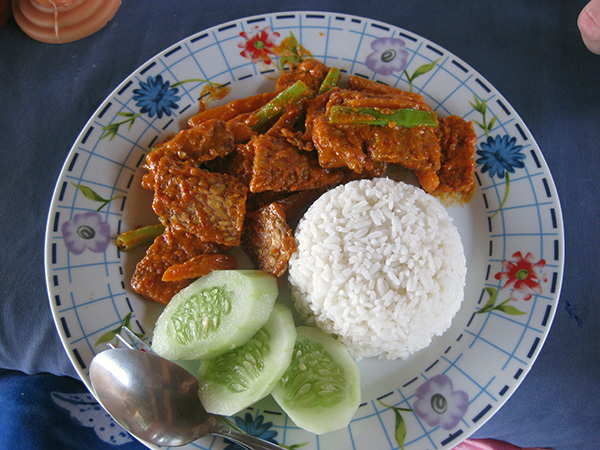There is a reason for this phenomenon.
Aziz is a young Sasak who invited me to spend a few days getting to know his home: a tiny village of around 20 inhabitants on the shores of Areguling Beach, off the road to Mawun. When I arrive Aziz, machete in hand, scales a 15-metre tree to offer me a welcome beverage: a freshly cut coconut. 'This is the healthiest food there is, ' Aziz assures me. 'The best coconuts are usually five to seven months old and this one must be about six months old.'
The most beneficial thing about this drink is going to get it yourself.
As well as its being extremely refreshing and thirst-quenching, there are numerous other benefits to drinking coconut water: it contains potassium, magnesium, sodium, calcium and phosphorous. 'But the most beneficial thing about this drink is going to get it yourself,' says Aziz, his eyes searching the trees for his next target.
Aziz usually climbs around five trees a day to harvest the best coconuts for his family. 'It's always the man who does this task. And he must be in good physical condition to climb up so high,' he says, proud of his body, which is in peak condition thanks to a very active life.
It's the healthiest food there is. The best coconuts are usually five to seven months old.
While in the West we pay for gym membership to compensate for all those hours spent sitting in front of a computer each day, and try all sorts of trendy diets ands techniques to obtain the perfect body we've been told we need, the Sasak all have six packs, despite never having done a single crunch or push up.
The Sasaks do very physical work. Most of them live off farming. Many of the women toil in the rice fields, while the men work with pickaxe and shovel to cultivate the land. Due to the high temperatures, they usually work a maximum of three to four hours a day. That is enough for them to live comfortably. 'We eat, our children go to school and sometimes we can afford the occasional treat,' Aziz says, showing off his new plough.
They spend the rest of the day by the sea, chatting to their family and neighbours, far from any technological stimuli. They don't follow trends, they have no idea what an emoticon is, and they don't even know the meaning of the word 'stress'.
The Sasak diet is simple but nutritious. They eat three times a day. Portions are small, but I'm surprised how quickly I get used to this. I tell the Sasaks that in my country we drink coffee after our meals but they just don't get it. Because coffee works as an appetite suppressant, the Sasaks drink it before each meal as a way of preparing their stomachs not to eat too voraciously. They use bananas and papayas to similar effect: snacking on them between or just before meals.
Because coffee works as an appetite suppressant they drink it before each meal.
Rice is their staple food, usually accompanied by fish, meat or vegetables. Sometimes they even eat it with nothing more than boiled peanuts. 'Rice gives us energy to work and climb trees. We have it with all our meals, even breakfast,' says Aziz, his left hand full of rice. And although many people think rice is fattening and have demonised it to some extent, the truth is it's rich in fibre and low in sodium, and it contains many antioxidants and diuretic and anti-inflammatory properties.
Rice gives us energy to work and climb trees. We have it with all our meals.
Certainly, in the weeks I spent with the Sasak community I felt light and strong. Was it the rice? The coffee before meals? The boiled peanuts? Or maybe the coconut water? Or perhaps the spiciness of the food had something to do with it. As in many Asian countries, the meals here are spicy: very. Red chili contains plenty of vitamins, as well as working as a pain killer; there are even studies which suggest capsaicin – responsible for the burning sensation chili provokes – can aid in the elimination of cancer cells. Perhaps that's why they chew chili all day here.
The Sasak community does not know the meaning of the term 'alkaline' foods. It does not even know what cancer is. They stick to their traditional diet, based on the few resources they have at their disposal, and yet, according to data collected by the World Health Organisation in 2016, the incidence rate of cancer in Indonesia is far lower (133 cases per 100,000 inhabitants) than in Western nations such as Spain (249 cases per 100,000 inhabitants).
My return to Europe is hard. I've spent more than 20 days away from the hustle and bustle of the West. At the airport I find myself surrounded by advertisements, people glued to their mobile phones, and fast food restaurants. 'I'd rather have rice with peanuts and a fresh coconut. Might it be that less is more?' I wonder, as I recall Aziz and his family.
People with few resources but plenty of smiles; with no nutritionists but in excellent health; with no gyms but lots of muscles. This is their masterful lesson on how to stay in shape: 'Work a little, eat only when your body asks for food, and climb (if you can) the highest palm tree five times a day.'
Could it be that sometimes less is more?






